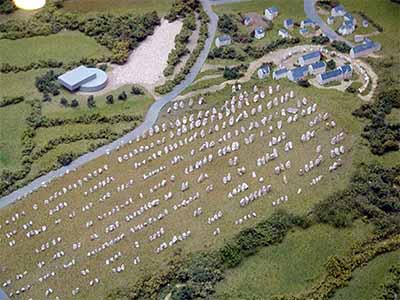Carnac Alignments
What Are Menhirs For ?

Le Ménec, a small French village one kilometer from Carnac, in Morbihan, is the starting point for four routes lined with thousands of standing stones divided into eleven alignments. Near Kermario is the so-called “Kercado” mound where burials dating from 4700 BC have been found : archaeological data which is of remarkable scientific interest to define a chronology of the site of Carnac as a whole.
Many menhirs were cut down, however it is still possible today to observe these megalithic alignments which extend for more than 4 kilometers on the site of Carnac. The most complex structure is that of Le Ménec: the stones form an ellipse composed of 70 menhirs which on the whole measure a little less than a meter and a half. To the east rise 1,099 stones forming eleven alignments which make up a fascinating and unique spectacle in the world rendering Carnac the dream place for fervent menhir fanatics.
In 1827, the Chevalier de Frémville described the Carnac site as follows: “This regiment of stones, this incredible tangle of shapeless rocks with perfectly symmetrical alignment, left me speechless (...); the large number of weirdly arranged masses, the height of some of these lichen-covered forms, gray and long, which stand out on the brown earth in which they are deeply planted, as well as the silence which surrounds them excites the imagination and fills the soul of a melancholy veneration for these testimonies of times gone by.” These impressions are still valid today: it is always impossible to remain indifferent to this prehistoric temple designed to give a face and a meaning to the sacredness of stone, symbol of eternity and essential material in the life of these men who were going to build Europe.
What are menhirs for ?

The menhir (of men, “stone” and hir, “long”) is probably the most enigmatic element of megalithic culture. Made of a simple vertical stone stuck in the ground, this strange monument, very present in the Celtic cultural world, has always attracted the attention of archaeologists and has been the subject of in-depth studies. Like all other stones marked by the hand of man, the menhirs maintain close links with the sacred. However, we have so far never succeeded in defining the precise ritual function of the menhir. Since we have not found at their feet objects allowing them to be dated, it is very difficult to know precisely when the menhirs were built. However, these are generally works produced from the Neolithic period, which were subsequently integrated into the Celtic religious tradition.
When paganism meets Christianity
Local tradition claims that the standing stones of Carnac are Roman soldiers petrified by Saint Cornelius in order to bar the way to their pagan cults before having to rub their bloody swords. Paganism is however still present under the Christian varnish, so much so that in the parish church of Carnac, the saint is represented inside a cromlech (a circle of stones made up of several menhirs) blessing two oxen.
Even today, every September 13, the locals come to have their animals blessed in the local church, thus repeating a rite perhaps older than Christianity: some indeed maintain that in Carnac, the rituals with the animals were already broadcast before the arrival of the evangelizers, and it was the latter who absorbed into the new worship a tradition that was much earlier and rooted in the local religion. The aspect changes but, basically, it is indeed the old symbolism which endures. Like Saint Cornelius, Saint Genevieve is represented inside a cromlech and surrounded by numerous domestic animals. The persistence of the pagan cult is once again highlighted in the local religion: this saint is invoked to promote childbirth and to make the rain fall. These are the remains of ancient fertility cults practiced by the natives who, before the arrival of Christianity, found among the stones the most suitable place to ask for help from their deities. Finally, researchers recently established that the Carnac site would also have had an astronomical function: it would have been designed to observe the moon.









































































































































































































































































































































